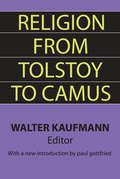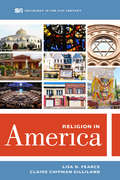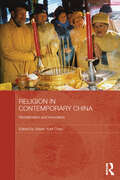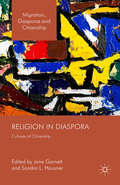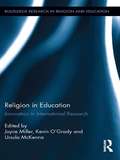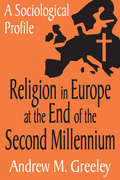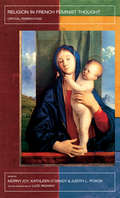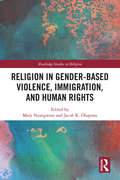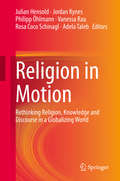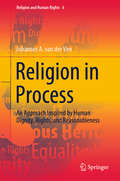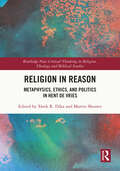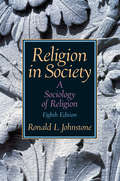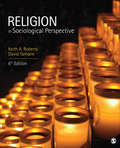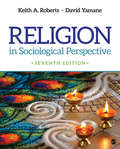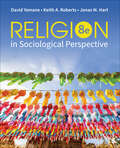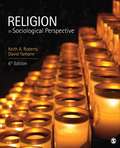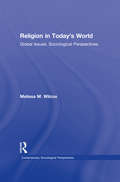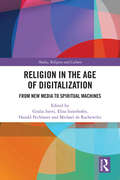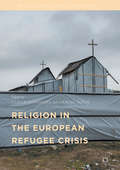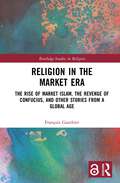- Table View
- List View
Religion from Tolstoy to Camus
by Walter Kaufmann Paul GottfriedWalter Kaufmann devoted his life to exploring the religious implications of literary and philosophical texts. Deeply skeptical about the human and moral benets of modern secularism, he also criticized the quest for certainty pursued through dogma. Kaufmann saw a risk of loss of authenticity in what he described as unjustied retreats into the past. This is a compilation of signicant texts on religious thought that he selected and introduced.
Religion in America (Sociology in the Twenty-First Century #6)
by Lisa D. Pearce Claire Chipman GillilandWritten in an engaging and accessible tone, Religion in America probes the dynamics of recent American religious beliefs and behaviors. Charting trends over time using demographic data, this book examines how patterns of religious affiliation, service attendance, and prayer vary by race and ethnicity, social class, and gender. The authors identify demographic processes such as birth, death, and migration, as well as changes in education, employment, and families, as central to why some individuals and congregations experience change in religious practices and beliefs while others hold steady. Religion in America challenges students to examine the demographic data alongside everyday accounts of how religion is experienced differently across social groups to better understand the role that religion plays in the lives of Americans today and how that is changing.
Religion in Contemporary China: Revitalization and Innovation (Routledge Contemporary China Series)
by Adam Yuet ChauBefore the modernist transformations of the twentieth century, China had one of the richest and most diverse religious cultures in the world. The radical anti-traditionalist policies of both the Republican and Communist regimes as well as other socio-historical factors posed formidable challenges to China’s religious traditions but, this book argues, these conditions also presented new opportunities for re-generation and innovation. It shows that economic reforms and the concurrent relaxation of religious policies have provided fertile ground for the revitalization of a wide array of religious practices, including divination, ancestor worship, temple festivals, spirit mediumism, churchgoing, funeral rites, exorcism, pilgrimages, sectarianism, sutra chanting, and the printing and distribution of morality books. Equally new forms of religious practices have emerged such as lay Buddhist preachers, "Maoist shamans", and a range of qigong sects/schools. Written by an international, interdisciplinary team of experts who have all conducted in-depth fieldwork research in China, this book provides a wide-ranging survey of contemporary religious practices in China. It examines the different processes and mechanisms of religious revivals and innovations, and, more broadly, relates the Chinese example of religious revitalization to larger issues of social and cultural continuity and change.
Religion in Diaspora: Cultures of Citizenship (Migration, Diasporas and Citizenship)
by Sondra L. Hausner Jane GarnettThis edited collection addresses the relationship between diaspora, religion and the politics of identity in the modern world. It illuminates religious understandings of citizenship, association and civil society, and situates them historically within diverse cultures of memory and state traditions.
Religion in Education: Innovation in International Research (Routledge Research in Religion and Education)
by Joyce Miller Kevin O’Grady Ursula McKennaThis volume explores numerous themes (including the influence of ethnography on religious education research and pedagogy, the interpretive approach to religious education, the relationship between research and classroom practice in religious education), providing a critique of contemporary religious education and exploring the implications of this critique for initial and continuing teacher education.
Religion in Europe at the End of the Second Millenium: A Sociological Profile
by Andrew M. GreeleyMost sociologists of religion describe a general decline in religious faith and practice in Europe over the last two centuries. The secularizing forces of the Enlightenment, science, industrialization, the influence of Freud and Marx, and urbanization are all felt to have diminished the power of the churches and demystified the human condition. In Andrew Greeley's view, such overarching theories and frameworks do not begin to accommodate a wide variety of contrasting and contrary social phenomena. Religion at the End of the Second Millennium engages the complexities of contemporary Europe to present a nuanced picture of religious faith rising, declining, or remaining stable.
Religion in French Feminist Thought: Critical Perspectives
by Morny Joy Kathleen O’Grady Judith L. PoxonReligion in French Feminist Thought: Critical Perspectives brings together some of the leading modern religious responses to major French feminist writings on religion. It considers central figures such as Hélène Cixous, Julia Kristeva, Luce Irigaray and Catherine Clément, and its focus on questions of divinity, subjectivity, and ethics provides an accessible introduction to an area of growing philosophical interest.Illustrating the ways in which French feminism has become a valuable tool in feminist efforts to rethink religion, and responding to its promise as an intellectual resource for religious philosophy in the future, Religion in French Feminist Thought is ideal both for independent use and as a companion book to French Feminists on Religion (Routledge, 2001).
Religion in Gender-Based Violence, Immigration, and Human Rights (Routledge Studies in Religion)
by Jacob K. Olupona Mary NyangwesoThis book builds on work that examines the interactions between immigration and gender-based violence, to explore how both the justification and condemnation of violence in the name of religion further complicates our societal relationships. Violence has been described as a universal challenge that is rooted in the social formation process. As humans seek to exert power on the other, conflict occurs. Gender based violence, immigration, and religious values have often intersected where patriarchy-based power is exerted on the other. An international panel of contributors take a multidisciplinary approach to investigating three central themes. Firstly, the intersection between religion, immigration, domestic violence, and human rights. Secondly, the possibility of collaboration between various social units for the protection of immigrants’ human rights. Finally, the need to integrate faith-based initiatives and religious leaders into efforts to transform attitude formation and general social behavior. This is a wide-ranging and multi-layered examination of the role of religion in gender-based violence and immigration. As such, it will be of keen interest to academics working in religious studies, gender studies, politics, and ethics.
Religion in Motion: Rethinking Religion, Knowledge and Discourse in a Globalizing World
by Philipp Öhlmann Julian Hensold Jordan Kynes Vanessa Rau Rosa Coco Schinagl Adela TalebThis volume offers innovative approaches to the study of religion. It brings together junior and senior scholars from the Global North and South. The contributors also explore the context-specific formations of religion and religious knowledge production in an increasingly instable and incalculable, globalized world.In the spirit of the challenging slogan, “Religion in Motion. Rethinking Religion, Knowledge and Discourse in a Globalizing World,” the book bundles voices from a great variety of cultural and academic backgrounds. It offers readers a cross-continental exchange of innovative approaches in the study of religion. Coverage intersects religion, gender, economics, and politics. In addition, it de-centers European perspectives and brings in perspectives from the Global South.Chapters examine such topics as feminine power and agency in the Ilê Axé Oxum Abalô, queering the Trinity, and faith and professionalism in humanitarian encounters in post-earthquake Haiti. Coverage also explores notions of development in African initiated churches and their implications for development policy, the study of religion as the study of discourse construction, rethinking the religion/secularism binary in world politics, and more. This book will appeal to students and researchers with an interest in Religion and Society, Philosophy and Religion, and Religion and Gender.
Religion in Process: An Approach Inspired by Human Dignity, Rights, and Reasonableness (Religion and Human Rights #6)
by Johannes A. van der VenThis book argues that contemporary Christianity is in crisis because freedom of religion is concealed and under pressure by secularization and migration. A drastic change is necessary - in the Catholic Church at first - from a God-given hierarchical structure to a democratic religion that rests on human dignity and human rights.The text conveys that such a change -that should happen from within- will put an end to challenges such as in Catholicism where outside human rights are promoted, but from inside a different story is told. Cultural change in religion is also covered with the move from centuries-old dictates to the reasonable justification of freedom of experiences, symbols, rituals and inter-religious intercourse as well as the cross communication between believers and non-believers alike. This approach makes religion an as yet unfinished religion. The text appeals to researchers and academics working in human rights and religion.
Religion in Reason: Metaphysics, Ethics, and Politics in Hent de Vries (Routledge New Critical Thinking in Religion, Theology and Biblical Studies)
by Martin Shuster Tarek R. DikaThis book presents critical engagements with the work of Hent de Vries, widely regarded as one of the most important living philosophers of religion. Contributions by a distinguished group of scholars discuss the role played by religion in philosophy; the emergence and possibilities of the category of religion; and the relation between religion and violence, secularism, and sovereignty. Together, they provide a synoptic view of how de Vries’s work has prompted a reconceptualization of how religion should be studied, especially in relation to theology, politics, and new media. The volume will be of particular interest to scholars of religious studies, theology, and philosophy.
Religion in Society: A Sociology of Religion
by Ronald L. JohnstoneFor junior/senior-level courses in Religion and Society in departments of Sociology and Religious Studies. Using an unbiased, balanced approach, the 8th edition of this text puts religion in its social context by discussing the impact of society on religion and helps students understand the role and function of religion in society that occur regardless of anyone's claims about the truth or falsity of religious systems.
Religion in Sociological Perspective
by Keith A. Roberts David A. YamaneThis fully updated Sixth Edition of Religion in Sociological Perspective introduces students to the basic theories and methods in the field, and shows them how to apply these analytic tools to new groups they encounter. Authors Keith A Roberts and David Yamane explore three interdependent subsystems of religion—meaning, structure, and belonging—and their connections to the larger social structure. While they cover the major theoretical paradigms of the field and employ various middle-range theories to explore specific processes, they use the open systems model as a single unifying framework to integrate the theories and enhance student understanding.
Religion in Sociological Perspective
by Keith A. Roberts David A. YamaneThis fully updated Sixth Edition of Religion in Sociological Perspective introduces students to the basic theories and methods in the field, and shows them how to apply these analytic tools to new groups they encounter. Authors Keith A Roberts and David Yamane explore three interdependent subsystems of religion—meaning, structure, and belonging—and their connections to the larger social structure. While they cover the major theoretical paradigms of the field and employ various middle-range theories to explore specific processes, they use the open systems model as a single unifying framework to integrate the theories and enhance student understanding.
Religion in Sociological Perspective
by Keith A. Roberts David A. Yamane<!-- /* Font Definitions */ @font-face {font-family:"Cambria Math"; panose-1:2 4 5 3 5 4 6 3 2 4; mso-font-charset:0; mso-generic-font-family:roman; mso-font-pitch:variable; mso-font-signature:-536870145 1107305727 0 0 415 0;} @font-face {font-family:Tahoma; panose-1:2 11 6 4 3 5 4 4 2 4; mso-font-charset:0; mso-generic-font-family:swiss; mso-font-pitch:variable; mso-font-signature:-520081665 -1073717157 41 0 66047 0;} /* Style Definitions */ p.MsoNormal, li.MsoNormal, div.MsoNormal {mso-style-unhide:no; mso-style-qformat:yes; mso-style-parent:""; margin:0in; margin-bottom:.0001pt; mso-pagination:widow-orphan; font-size:10.0pt; font-family:"Tahoma",sans-serif; mso-fareast-font-family:"Times New Roman"; mso-bidi-font-family:"Times New Roman";} .MsoChpDefault {mso-style-type:export-only; mso-default-props:yes; font-size:10.0pt; mso-ansi-font-size:10.0pt; mso-bidi-font-size:10.0pt;}size:8.5in 11.0in; margin:1.0in 1.0in 1.0in 1.0in; mso-header-margin:.5in; mso-footer-margin:.5in; mso-paper-source:0;} div.WordSection1 {page:WordSection1;} Religion in Sociological Perspective introduces you to the systems of meaning, structure, and belonging that make up the complex social phenomena we know as religion. Authors Keith A. Roberts and David Yamane use an active learning approach to illustrate the central theories and methods of research in the sociology of religion and show you how to apply these analytical tools to new groups they encounter. The Seventh Edition departs from previous editions by emphasizing that the sociology of religion is an ongoing conversation among scholars in dialogue with existing scholarship and the social world. This perspective is established in the new second chapter, &“Historical Development of the Sociology of Religion.&” Other chapters feature important voices from the past alongside the views of contemporary sociologists, and conclude with a glimpse of where the sociology of religion might be heading in the future. At every opportunity, the text has been enriched by research and examples that are meant to challenge parochial limits in the sociology of religion, pushing beyond Christianity, congregations, beliefs, national borders (especially the United States), and even beyond religion itself (to take nonreligion more seriously).
Religion in Sociological Perspective
by Keith A. Roberts David A. Yamane<!-- /* Font Definitions */ @font-face {font-family:"Cambria Math"; panose-1:2 4 5 3 5 4 6 3 2 4; mso-font-charset:0; mso-generic-font-family:roman; mso-font-pitch:variable; mso-font-signature:-536870145 1107305727 0 0 415 0;} @font-face {font-family:Tahoma; panose-1:2 11 6 4 3 5 4 4 2 4; mso-font-charset:0; mso-generic-font-family:swiss; mso-font-pitch:variable; mso-font-signature:-520081665 -1073717157 41 0 66047 0;} /* Style Definitions */ p.MsoNormal, li.MsoNormal, div.MsoNormal {mso-style-unhide:no; mso-style-qformat:yes; mso-style-parent:""; margin:0in; margin-bottom:.0001pt; mso-pagination:widow-orphan; font-size:10.0pt; font-family:"Tahoma",sans-serif; mso-fareast-font-family:"Times New Roman"; mso-bidi-font-family:"Times New Roman";} .MsoChpDefault {mso-style-type:export-only; mso-default-props:yes; font-size:10.0pt; mso-ansi-font-size:10.0pt; mso-bidi-font-size:10.0pt;}size:8.5in 11.0in; margin:1.0in 1.0in 1.0in 1.0in; mso-header-margin:.5in; mso-footer-margin:.5in; mso-paper-source:0;} div.WordSection1 {page:WordSection1;} Religion in Sociological Perspective introduces you to the systems of meaning, structure, and belonging that make up the complex social phenomena we know as religion. Authors Keith A. Roberts and David Yamane use an active learning approach to illustrate the central theories and methods of research in the sociology of religion and show you how to apply these analytical tools to new groups they encounter. The Seventh Edition departs from previous editions by emphasizing that the sociology of religion is an ongoing conversation among scholars in dialogue with existing scholarship and the social world. This perspective is established in the new second chapter, &“Historical Development of the Sociology of Religion.&” Other chapters feature important voices from the past alongside the views of contemporary sociologists, and conclude with a glimpse of where the sociology of religion might be heading in the future. At every opportunity, the text has been enriched by research and examples that are meant to challenge parochial limits in the sociology of religion, pushing beyond Christianity, congregations, beliefs, national borders (especially the United States), and even beyond religion itself (to take nonreligion more seriously).
Religion in Sociological Perspective
by Keith A. Roberts David A. Yamane Jonas M. HartReligion in Sociological Perspective, Eighth Edition?introduces the systems of meaning, structure, and belonging that make up the complex social phenomena we know as religion. The author team uses an active learning approach to illustrate the central theories and methods of research in the sociology of religion and show students how to apply these analytical tools to new groups they encounter.
Religion in Sociological Perspective
by Keith A. Roberts David A. Yamane Jonas M. HartReligion in Sociological Perspective, Eighth Edition?introduces the systems of meaning, structure, and belonging that make up the complex social phenomena we know as religion. The author team uses an active learning approach to illustrate the central theories and methods of research in the sociology of religion and show students how to apply these analytical tools to new groups they encounter.
Religion in Sociological Perspective
by David Yamane Keith A. RobertsAuthors Keith A Roberts and David Yamane explore three interdependent subsystems of religion—meaning, structure, and belonging—and their connections to the larger social structure. While they cover the major theoretical paradigms of the field and employ various middle-range theories to explore specific processes, they use the open systems model as a single unifying framework to integrate the theories and enhance student understanding.
Religion in Today's World: Global Issues, Sociological Perspectives (Sociology Re-Wired)
by Melissa M. WilcoxReligion is a major force in contemporary society. It is also one of the least understood social and political influences on individuals and communities. In this innovative collection of original essays and classic readings, experts explore the significance of contemporary religiosity: as a source of meaning and motivation, how it unites and divides us, and how it is used politically and culturally. Readers will be introduced to the broad debates in ways that will equip them to analyze, discuss, and make their own judgments about religion and society. This book should be read by anyone interested in understanding religion as a central source of meaning and politics, and is ideally suited for undergraduate teaching on religion and social issues and from a global perspective.
Religion in the Age of Digitalization: From New Media to Spiritual Machines (Routledge Research in Religion, Media and Culture)
by Giulia Isetti; Elisa Innerhofer; Harald Pechlaner; Michael de RachewiltzThis book examines the current use of digital media in religious engagement and how new media can influence and alter faith and spirituality. As technologies are introduced and improved, they continue to raise pressing questions about the impact, both positive and negative, that they have on the lives of those that use them. The book also deals with some of the more futuristic and speculative topics related to transhumanism and digitalization. Including an international group of contributors from a variety of disciplines, chapters address the intersection of religion and digital media from multiple perspectives. Divided into two sections, the chapters included in the first section of the book present case studies from five major religions: Christianity, Islam, Buddhism, Hinduism and Judaism and their engagement with digitalization. The second section of the volume explores the moral, ideological but also ontological implications of our increasingly digital lives. This book provides a uniquely comprehensive overview of the development of religion and spirituality in the digital age. As such, it will be of keen interest to scholars of Digital Religion, Religion and Media, Religion and Sociology, as well as Religious Studies and New Media more generally, but also for every student interested in the future of religion and spirituality in a completely digitalized world.
Religion in the European Refugee Crisis (Religion and Global Migrations)
by Graeme Smith Ulrich SchmiedelThis book explores the roles of religion in the current refugee crisis of Europe. Combining sociological, philosophical, and theological accounts of this crisis, renowned scholars from across Europe examine how religion has been employed to call either for eliminating or for enforcing the walls around “Fortress Europe.” Religion, they argue, is radically ambiguous, simultaneously causing social conflict and social cohesion in times of turmoil. Charting the constellations, the conflicts, and the consequences of the current refugee crisis, this book thus answers the need for succinct but sustained accounts of the intersections of religion and migration.
Religion in the Market Era: The Rise of Market Islam, the Revenge of Confucius, and Other Stories From a Global Age (Routledge Studies in Religion)
by François GauthierThis book aims to expand the limits of the social-scientific study of religion and define a coherent model of recent global transformations of religion, challenging the paradigm of secularisation and post-secularisation. Using a wide-ranging selection of case studies, including global Islam, post-Soviet Eastern Europe, and China, the author argues that since the 1980s, religion has been dramatically shaped around the world by neoliberalism and consumerism. Providing a global, macro-level history of how religion has changed in the past four decades, this book contends that the rise of economics as a dominant social sphere is central to understanding the ongoing changes in contemporary world religions.
Religion in the Public Sphere
by Lori G. Beaman Solange LefebvreThe place of religion in the public realm is the subject of frequent and lively debate in the media, among academics and policymakers, and within communities. With this edited collection, Solange Lefebvre and Lori G. Beaman bring together a series of case studies of religious groups and practices from all across Canada that re-examine and question the classic distinction between the public and private spheres.Religion in the Public Sphere explores the public image of religious groups, legal issues relating to "reasonable accommodations," and the role of religion in public services and institutions like health care and education. Offering a wide range of contributions from religious studies, political science, theology, and law, Religion in the Public Sphere presents emerging new models to explain contemporary relations between religion, civil society, the private sector, family, and the state.
Religion in the Ranks
by Joanne Rennick Romeo DallaireWhat role does religion play in the Canadian Forces today? Examining the changing functions of the official religious leaders in the chaplaincy as well as the place and purpose of religion in the lives of regular military personnel, Religion in the Ranks explores this question in the context of late modernity and the Canadian secular state.In-depth interviews with chaplains and with personnel of differing spiritual beliefs offer insight into how religion affects the real life experiences of those who have endured difficult assignments, witnessed atrocities, and struggled to overcome post-traumatic stress disorder. While identifying the historic function of religion in the Canadian Forces, Joanne Benham Rennick demonstrates that spiritual interests remain important, even to those who do not consider themselves to be religious. Arguing that the leadership, practices, and beliefs rooted in religious affiliations create essential support systems for individuals, both at home and on assignment, Benham Rennick shows that there is still a place for religion in Canada's military.
